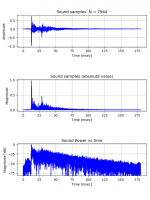Thanks for the technical update on your signal capture. That's helpful.
Up here in New England right now isn't conducive to much outdoor testing. When the weather moderates I can try something similar. I may try something indoors, but that will require some serious acoustic work, or some cleverness on my part to overcome the environmental issues (echo). Was thinking of rigging an acoustic tunnel, but that's just a bit of a pipe dream at the moment. In my work life I've made anechoic chambers, but hey, there were budgets for that.
The properties of carbon fiber are attractive from quite a few perspectives. But for fooling around, it didn't make sense for me to source relatively large diameter CF tubing, at least not until my design(s) warranted the investment. I did get some small CF tubing (25mm OD/ 22mm ID) and was able to thread the inside diameter fairly reliably on my lathe. Coupled with matched machined aluminum end caps, it makes a nice looking, rugged moderator.
For giggles and grins, I did a test fire with a gyroid infill moderator indoors. This was with a iMM-6 calibrated Measurement microphone connected to Audacity on my PC. I adjusted the microphone gain until there was no clipping. (1/8 volume, what ever that is!) Microphone was only 0.5m away from the LDC muzzle.
I just did this to look at the acoustics of the room. Nothing is calibrated relative to an unmuffled shot. What I did see was an exponential ring down of the envelope, as well as an echo corresponding to one of the walls. (@ 28ms) I wrote a python script to plot the graph below. First trace is simply the amplitude vs time, second is the magnitude vs time, third is the power expressed in dB's vs time. The straight line in dB's (for a long time) is the exponential decay of the signal. It's hard to recognize in the linear domain, but it's real obvious in the dB domain.

Here's the wav file if you are interested.
